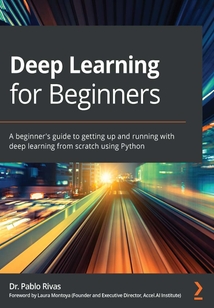舉報 

會員
Deep Learning for Beginners
Withinformationonthewebexponentiallyincreasing,ithasbecomemoredifficultthanevertonavigatethrougheverythingtofindreliablecontentthatwillhelpyougetstartedwithdeeplearning.Thisbookisdesignedtohelpyouifyou’reabeginnerlookingtoworkondeeplearningandbuilddeeplearningmodelsfromscratch,andalreadyhavethebasicmathematicalandprogrammingknowledgerequiredtogetstarted.Thebookbeginswithabasicoverviewofmachinelearning,guidingyouthroughsettinguppopularPythonframeworks.Youwillalsounderstandhowtopreparedatabycleaningandpreprocessingitfordeeplearning,andgraduallygoontoexploreneuralnetworks.Adedicatedsectionwillgiveyouinsightsintotheworkingofneuralnetworksbyhelpingyougethands-onwithtrainingsingleandmultiplelayersofneurons.Later,youwillcoverpopularneuralnetworkarchitecturessuchasCNNs,RNNs,AEs,VAEs,andGANswiththehelpofsimpleexamples,andyouwillevenbuildmodelsfromscratch.Attheendofeachchapter,youwillfindaquestionandanswersectiontohelpyoutestwhatyou’velearnedthroughthecourseofthebook.Bytheendofthisbook,you’llbewell-versedwithdeeplearningconceptsandhavetheknowledgeyouneedtousespecificalgorithmswithvarioustoolsfordifferenttasks.
目錄(141章)
倒序
- 封面
- 版權信息
- About Packt
- Why subscribe?
- Foreword
- Contributors
- About the author
- About the reviewers
- Packt is searching for authors like you
- Preface
- Who this book is for
- What this book covers
- To get the most out of this book
- Get in touch
- Section 1: Getting Up to Speed
- Introduction to Machine Learning
- Diving into the ML ecosystem
- Training ML algorithms from data
- Introducing deep learning
- Why is deep learning important today?
- Summary
- Questions and answers
- References
- Setup and Introduction to Deep Learning Frameworks
- Introduction to Colaboratory
- Introduction and setup of TensorFlow
- Introduction and setup of Keras
- Introduction to PyTorch
- Introduction to Dopamine
- Other deep learning libraries
- Summary
- Questions and answers
- References
- Preparing Data
- Binary data and binary classification
- Categorical data and multiple classes
- Real-valued data and univariate regression
- Altering the distribution of data
- Data augmentation
- Data dimensionality reduction
- Ethical implications of manipulating data
- Summary
- Questions and answers
- References
- Learning from Data
- Learning for a purpose
- Measuring success and error
- Identifying overfitting and generalization
- The art behind learning
- Ethical implications of training deep learning algorithms
- Summary
- Questions and answers
- References
- Training a Single Neuron
- The perceptron model
- The perceptron learning algorithm
- A perceptron over non-linearly separable data
- Summary
- Questions and answers
- References
- Training Multiple Layers of Neurons
- The MLP model
- Minimizing the error
- Finding the best hyperparameters
- Summary
- Questions and answers
- References
- Section 2: Unsupervised Deep Learning
- Autoencoders
- Introduction to unsupervised learning
- Encoding and decoding layers
- Applications in dimensionality reduction and visualization
- Ethical implications of unsupervised learning
- Summary
- Questions and answers
- References
- Deep Autoencoders
- Introducing deep belief networks
- Making deep autoencoders
- Exploring latent spaces with deep autoencoders
- Summary
- Questions and answers
- References
- Variational Autoencoders
- Introducing deep generative models
- Examining the VAE model
- Comparing a deep and shallow VAE on MNIST
- Thinking about the ethical implications of generative models
- Summary
- Questions and answers
- References
- Restricted Boltzmann Machines
- Introduction to RBMs
- Learning data representations with RBMs
- Comparing RBMs and AEs
- Summary
- Questions and answers
- References
- Section 3: Supervised Deep Learning
- Deep and Wide Neural Networks
- Wide neural networks
- Dense deep neural networks
- Sparse deep neural networks
- Hyperparameter optimization
- Summary
- Questions and answers
- References
- Convolutional Neural Networks
- Introduction to convolutional neural networks
- Convolution in n-dimensions
- Convolutional layers
- Pooling strategies
- Convolutional neural network for CIFAR-10
- Summary
- Questions and answers
- References
- Recurrent Neural Networks
- Introduction to recurrent neural networks
- Long short-term memory models
- Sequence-to-vector models
- Vector-to-sequence models
- Sequence-to-sequence models
- Ethical implications
- Summary
- Questions and answers
- References
- Generative Adversarial Networks
- Introducing adversarial learning
- Training a GAN
- Comparing GANs and VAEs
- Thinking about the ethical implications of GANs
- Summary
- Questions and answers
- References
- Final Remarks on the Future of Deep Learning
- Looking for advanced topics in deep learning
- Learning with more resources from Packt
- Summary
- References
- Other Books You May Enjoy
- Leave a review - let other readers know what you think 更新時間:2021-06-11 18:20:47
推薦閱讀
- FPGA從入門到精通(實戰篇)
- 龍芯應用開發標準教程
- Python GUI Programming:A Complete Reference Guide
- 計算機組裝與系統配置
- BeagleBone By Example
- Spring Cloud微服務架構實戰
- 筆記本電腦維修實踐教程
- FL Studio Cookbook
- STM32自學筆記
- Angular 6 by Example
- 嵌入式系統設計大學教程(第2版)
- 基于S5PV210處理器的嵌入式開發完全攻略
- Advanced Machine Learning with R
- PIC系列單片機的流碼編程
- 嵌入式系統原理:基于Arm Cortex-M微控制器體系
- 微型計算機原理及應用教程(第2版)
- Unreal Development Kit Game Programming with UnrealScript:Beginner's Guide
- 微處理器及控制電路識圖
- Windows Presentation Foundation 4.5 Cookbook
- FPGA的人工智能之路:基于Intel FPGA開發的入門到實踐
- 電腦組裝與硬件維修從新手到高手
- 系統安裝、維護及故障排除實戰
- 勇敢的芯伴你玩轉Nios II(電子設計與嵌入式開發實踐叢書)
- Fixing Bad UX Designs
- CANoe開發從入門到精通
- 提高C++性能的編程技術
- Hands-On Convolutional Neural Networks with TensorFlow
- Raspberry Pi Computer Architecture Essentials
- 筆記本電腦維修寶典
- STC單片機原理及應用:從器件、匯編、C到操作系統的分析和設計(立體化教程)(第2版)

